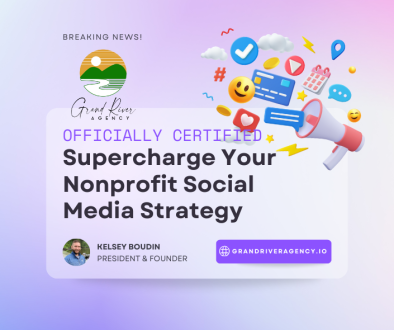Nonprofit Marketing & Advertising: The Whole Industry is Getting It Wrong
How has the nonprofit sector gone so wrong? The philosophies around charity are, well, overly charitable. Go ask a nonprofit executive, “What part of your budget do you micromanage most?” You’d be hard-pressed to find one that wouldn’t cite overhead as their budget-crunching nemesis. (Helpful hint: that includes nonprofit marketing and advertising.)
But why?
For decades, nonprofit fundraising and management philosophies have gradually devolved into a giant logical fallacy. It doesn’t even make sense. The word CHARITY has gone too far. It seems the entire nonprofit industry believes that “charity” means everything must be done for free.
If it weren’t for maximum volunteerism and praying for donations, minimal overhead and poor mission investment would’ve driven the nonprofit industry into the ground by now. Nonprofit marketing and advertising is an overhead expense that many misguided nonprofits approach with fear and trepidation. The alternative? Tackling marketing and communications tactics in-house with little or no experience – or wishing it away as something “nonprofits don’t really need like businesses do.”
So let’s redefine the value of nonprofit marketing and advertising. Nonprofits 100% NEED these communications mechanisms to reach their ACTUAL target audiences – big-money donors and grant funders.
Redefining the Value of Nonprofit Marketing & Advertising: Unlocking Serious Growth Potential
It’s no wonder the charitable industry in recent decades has come across so annoying. My 87-year-old father complains all the time about new mail solicitations for nonprofits THAT HE SUPPORTS. “They’re always looking for a handout,” he says. “What did they do with the $50 I gave them last month?!”
He has a point. What did they do? They are looking for a handout. That’s one of the ways nonprofits raise money, but they’re doing such a poor job communicating it that their continual invitations to give are met with disgust – the same way as that relative who always asks for a few bucks that you know will be spent at the liquor store.
The charities HE SUPPORTS aren’t tapping their storytelling potential to illustrate their impact and compel further donations. They aren’t INVESTING in the nonprofit marketing mechanism to supercharge their fundraising efforts – the lifeblood of their missions.
At least some nonprofit industry leaders have come around to the “spend money to make money” idea.
In a TED talk over 10 years ago – “The Way We Think About Charity is Dead Wrong” – Dan Pallotta raised a critical point about the double standard between the for-profit and nonprofit sectors. There’s a prevailing bias, he said, against nonprofits that invest in marketing and advertising, as the common belief is that donors do not want to see their contributions spent that way.
“Social problems are massive in scale, our organizations are tiny up against them, and we have a belief system that keeps them tiny. We have two rulebooks. We have one for the nonprofit sector, and one for the rest of the economic world. It’s an apartheid, and it discriminates against the nonprofit sector.” — Dan Pallotta
Pallotta’s argument highlights the power of strategic investments. He argues FOR overhead on nonprofit marketing and advertising. How else can charities like yours communicate with likely donors and supporters?
Investing in Nonprofit Marketing & Advertising: Overhead That Makes Sense
Nonprofits are just like any other business or organization. The only difference is your tax designation. You can achieve long-term sustainability by:
- Investing in talented individuals
- Paying competitive salaries
- Implementing effective advertising and marketing campaigns
- Developing new programs for impact
Considering overhead – THE RIGHT WAY – opens doors to innovative strategies that can transform your nonprofit impact.
Amplifying Reach & Impact
Nonprofits have transformative ideas that can improve society. But without proper exposure, these initiatives may go unnoticed. Marketing and advertising provide nonprofits with a platform to maximize their impact.
By leveraging and optimizing things like social media, website SEO, public relations and even print media, nonprofits can engage with diverse audiences that extend far beyond their immediate circle of supporters.
The Impact of Marketing & Advertising on Fundraising
I gave away the answer earlier, but it’s a question I always ask new nonprofit clients, typically at Board meetings where they’re deciding on our nonprofit marketing and fundraising services.
“What do you think of your organization’s digital presence?” The question is often met with awkward silence. To which I respond with another question, “If you were a grant funder or big donor looking at your website or social media, would you fund your nonprofit?” More crickets, almost as if they’re shocked. “They look at that?!”
Of course funders do!
Most small nonprofits, not knowing better, believe their communications mechanisms are important only for one thing: to inform the people they serve. Wrong! Heck, some of the people you serve may not have social media or haven’t visited your website once. As I said above, donors and grant funders are your target audience with the cash power to empower your mission.
By strategically allocating funds to promote their mission, nonprofits can reach a broader audience, and inspire more individuals to support their cause.
Building Trust & Credibility
Establishing a credible and trustworthy brand is key. Investing in nonprofit marketing and advertising helps organizations to create a strong brand identity and communicate their impact.
By sharing their stories, nonprofits can connect with potential donors on a deeper emotional level and nurture long-lasting relationships. Donors big and small probably won’t intuitively trust your organization. It takes more than saying, “We do good work in the community,” for people to believe you actually do good work. Anyone can say their organization is great, but are they worthy of a donation?
This communication plays a crucial role in cultivating accountability. At smaller touchpoints, you can release positive, outwardly focused messaging:
- Client testimonials demonstrating how their lives were improved
- Infographics easily showing with data how a community issue is resolving
- Blog posts explaining the depth of the problem and how your nonprofit solves it
- Podcasts discussing with key stakeholders the trajectory of community impact
The opportunities for ongoing narrative driving community engagement are nearly limitless.
Innovation & Adaptability
Investing in strategic communications drives innovation within nonprofit organizations. These endeavors encourage nonprofits to explore new strategies, embrace technology and stay relevant in a rapidly changing world.
That last point is critical. If you’re not keeping up in the digital realm, it doesn’t take long to fall behind. Any efforts to improve nonprofit marketing and advertising would have to work that much harder to catch up. Some organizations never do – and they slowly suffocate because of it.
Like any other important job, strategic communications take practice. By continually refining their messaging, and adapting to evolving trends, nonprofits can remain flexible and respond effectively to the challenges and opportunities that arise. Take it from me, I’ve written tens of thousands of articles and hundreds of thousands of social media posts and ads – and I’m STILL learning and improving.
Shifting the Donor Perspective
Grant funders and donors, too, have lost touch with reality. It’s astonishing how many grant processes list nonprofit marketing and advertising as ineligible activities. They want to see their money spent on direct impact, but a charity can’t have an impact without telling the world it exists.
Shifting the donor perspective requires a paradigm shift. Donors must begin to recognize that these investments are not wasteful, but strategic and impactful. By reframing the conversation and educating donors about the value of marketing and communications, nonprofits can create a collective understanding of how these efforts contribute to their ability to make a difference.
Building Sustainable Growth Through Nonprofit Marketing & Advertising
It’s time to challenge the misconception that nonprofit investments in marketing and communications are misplaced. By embracing these strategies, nonprofits can harness the power of effective communication in promoting and growing their vital community missions.
Strategic investments in nonprofit marketing and advertising – especially in the 21st-century digital realm – have become necessary tools for creating positive change in the world. Let’s share that truth! If you’d like to get started with your own nonprofit communications strategy, feel free to contact me here for a FREE consultation.

President and Founder, Grand River Agency
With over 19 years of diverse experience in print journalism, digital media marketing, and nonprofit administration, Kelsey Boudin founded Grand River Agency (formerly Southern Tier Communications Strategies) in 2020. The agency specializes in offering contract-based strategic communications, content marketing, grant proposals, website design, and public relations services to small businesses and nonprofits. Kelsey’s career spans roles as an editor, content creator, and grant writer, reflecting his expertise in leading successful digital marketing campaigns, securing funding, and executing various projects.




